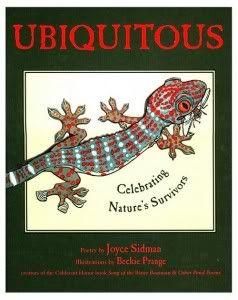Ubiquitous: Celebrating Nature's Survivors
by Joyce Sidman, illustrated by Beckie Prange
Houghton Mifflin
2010
What a glorious, glorious book this is! I am thoroughly enchanted, on so many levels. Ubiquitous is a perfect marriage of poetry and art and science. It's a collection of poems about various species that exist in huge numbers on the planet. Beginning with the incredible endpapers, showing a tightly drawn, swirling doodle representing a timeline, this book successfully conveys a sense of the vastness of geologic history. Bacteria show up relatively early, about 4 billion years after the Earth is formed, followed by a number of other organisms, including sharks (375 million years old), ants (140 million years old), dandelions (5 million years old) and finally humans, a mere 100,000 years old, showing us as a tiny blip at the end of the timeline.
Several different poetry forms are used, everything from a diamante (diamond-shaped poem) to concrete poetry to free verse. The concrete shark poem echoes it's subject precisely with the line "snout bristling teeth" forming the mouth of the shark, the fin created by the warning, "Shark! Shark! Shark!" ending in a tail made up of the words, "Power-pumping bursts/Long lazy strokes." The concrete poem devoted to squirrels is rather hilariously made in the shape of the squirrel as a long, continuous, hyper-frenetic run-on sentence. I rather enjoyed the metaphor used in The Mollusk That Made You where the mollusk is described as a "shy gray wizard" walking on one foot, wearing "a magic mantle,/trailing stars."
The bold-lined, brightly colored linocut illustrations nearly have the look of leaded stained glass, adding a reverence and majesty to the subject matter. I never could have imagined that bacteria, lichen and diatoms (single-celled, ocean-dwelling life forms) could look so beautiful. Any of the illustrations in the book would make a lovely piece of wall art.
Finally, each poem is paired with a paragraph of information about the subject of each poem, including the scientific name, average size, and additional info on the life cycle of each organism. The book is appended with a glossary of science terms. This is a book that belongs in every science classroom. I borrowed my copy from the library, but you can be sure I will be purchasing a copy of my own to keep.
I borrowed this book from the library.
Poetry Friday is hosted this week by A Year of Reading.

I don't read much poetry usually, but this book does sound really interesting and I love beautiful illustrations. Might have to pick it up just to see those!
ReplyDeleteI love it when poetry and science come together! Did you see last year's collection THE THREE THAT TIME BUILT? Fabulous!!!
ReplyDeleteThanks for the recommendation, Mary Lee. I did check it out - what a terrific line-up of of poets. Mary Ann Hoberman has arranged The Tree that Time Built in a way that would make any librarian proud: beautiful poems, arranged in geological order, with a glossary of poem and science terms, plus pages and pages of biographical info on each of the famous poets, plus an index! Phew! You know, I don't think the illustrations were as stunning as these, but they reminded me (just a little) of Rowling's line drawing illustrations in The Tales of Beedle the Bard.
ReplyDeleteAlso, I'm glad to see I'm not the only one blogging on Christmas Day!
Happy holidays to you.
I've heard great things about this book. About how many poems would you guess it includes?
ReplyDeleteIt is, a wonderful book. It should have 14 poems - I'm surprised by what a tremendous historical span it manages to cover in just over a dozen poems.
ReplyDelete